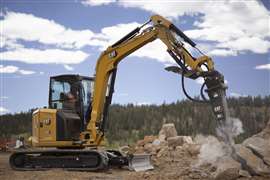Ten towers on Brazilian dam
17 January 2011
.gif)
Brazil's Santo Antonio dam is under construction by the Madeira Energia consortium using a fleet of 10 Liebherr tower cranes.
The hydroelectric power generation project is on the Madeira River in northern Brazil. Santo Antonio will have an installed capacity of 3,150 MW produced by 44 generators. It is a run-of-river design being built across an area of shallow rapids and an island that covers about half of the channel, to minimise the reservoir footprint. Bulb turbines, the largest of their kind ever built, will generate electricity from the natural flow of the river instead of from water under high pressure.
Consoricio Madeira Energia includes Brazilian construction firm Odebrecht and local power utilities Furnas and Companhia Energetica de Minas Gerais (Cemig). Also included are construction firm Andrade Gutierrez and Spanish bank Santander and Portuguese bank Banif.
The Madeira River is the largest tributary of the Amazon. Santo Antonio is 5 km upstream from the city of Porto Velho, near the Bolivian border.
Eight of the tower cranes are from the EC-H Litronic series. Four are 630 EC-H 40 Litronic with a capacity of 40 tonnes and a maximum radius of 80 m, at which the crane can lift 5.8 tonnes. The other four EC-H models are 40 tonne capacity 550 EC-H 40s, which lift 5.2 tonnes at the maximum jib radius of 81.5 m.
Also on site are two rail-mounted Liebherr 111 AS cranes.
Carlos Augusto Doares da Silva, project manager, said, "They were delivered to the site in 2008 and some of them will still be here in 2016, when the final phase of the project will be completed. So the structural strength of the cranes and their mechanical reliability is essential to us."
The dam and spillway comprise two 300 m concrete structures, one with 15 spans on the left bank of the river and the other with five spans at the channel between Presídio Island and the right bank.
Construction is in two stages, with cofferdams on the left bank diverting the flow to allow dry excavation and construction of roughly half the dam and the spillway. The river will then be routed through the completed portion of the dam, with new cofferdams built to protect the works in what will become the riverbed.



